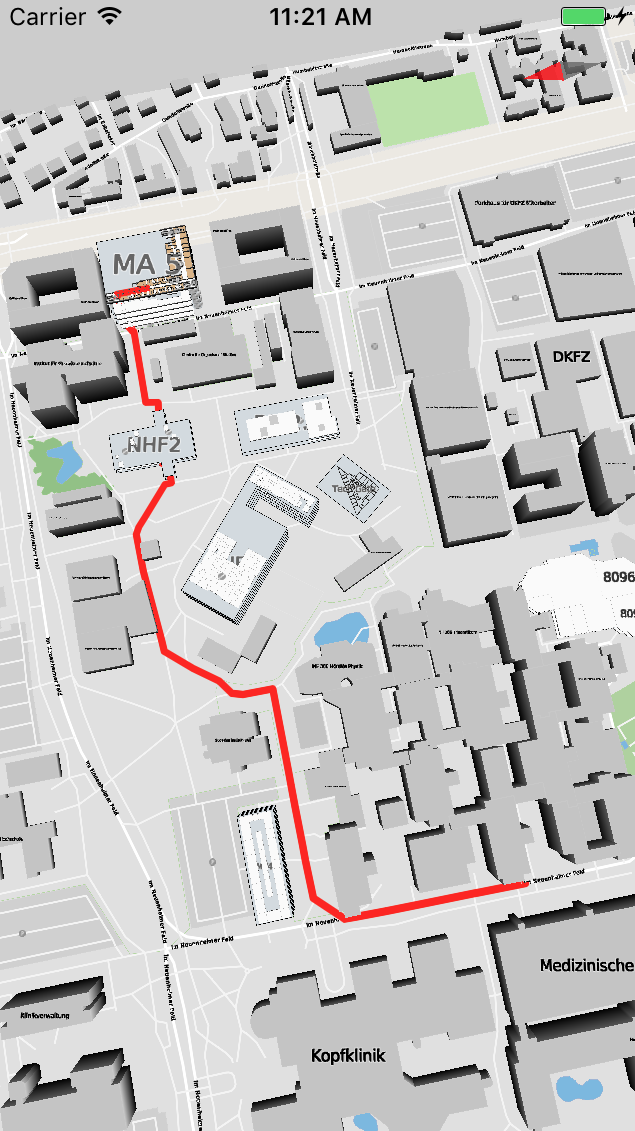Getting started with routing¶
In this part we take a look at how a route from point A to point B on the map can be created. To do this we create two members for our example view: startPoint and endPoint.
We also need to know if we already have set a start point once we want to create a route. Finally, if we want to draw a route to another location, we have to remove the previous route. We must therefore store the ID of the routing line as well.
Swift
// ViewController.swift
class ViewController: HDMMapViewController, HDMMapViewControllerDelegate {
var startPoint : HDMMapCoordinate?
...
}
Objective-C
// ViewController.m
@interface ViewController (){
@private
BOOL _startPointSet;
HDMMapCoordinate _startPoint;
}
@end
To create a route, we need to determine start and end points on the map. In this tutorial, we will do this with two interaction methods: tappedAtCoordinate and longPressedAtCoordinate.
First lets take a look at how to set our start point for the route. This is quite simple, we just use the point provided by our longPressedAtCoordinate callback:
Swift
// ViewController.swift
func mapViewController(_ controller: HDMMapViewController, longPressedAt coordinate: HDMMapCoordinate, features: [HDMFeature]){
print("Set routing start point!")
self.startPoint = coordinate
}
Objective-C
// ViewController.m
- (void)mapViewController:(HDMMapViewController *)controller longPressedAtCoordinate:(HDMMapCoordinate)coordinate features:(NSArray<HDMFeature *> *)features {
NSLog(@"Set routing start point!");
_startPoint = coordinate;
}
Next, we must create the route. In this tutorial we just create a route from our start point (set by long-press) to the end point which we now set with the tappedAtCoordinate callback:
Swift
// ViewController.swift
func mapViewController(_ controller: HDMMapViewController, tappedAt coordinate: HDMMapCoordinate, features: [HDMFeature]) {
guard let startPoint = self.startPoint else {return}
//1
guard let routing = controller.routing else {return}
//2
guard let route = routing.calculateRoute(from: startPoint, to: coordinate) else {return}
self.mapView.navigate(withPath:route, using: HDMUserTrackingModeNone)
}
Objective-C
// ViewController.m
-(void)mapViewController:(HDMMapViewController *)controller tappedAtCoordinate:(HDMMapCoordinate)coordinate features:(NSArray *)featureRefs {
if(_startPoint) {
HDMLocation *start = [HDMLocation locationWithCoordinate:_startPoint];
HDMLocation *dest = [HDMLocation locationWithCoordinate:coordinate];
HDMRoutingPathFeature *routeInfo = [self.mapViewController.routing calculateRouteFromLocation:start toDestination:dest];
[self.mapViewController.mapView navigateWithPath:routeInfo usingTrackingMode:HDMUserTrackingModeFollow];
}
}
That’s it!
In order to create a route on the map, hold your finger down on a point, then tap somewhere else on the map. You should now see a routing line appear that will look like this:
Routing instructions and localization
In case you also would like to provide step-by-step routing instructions to your users you can find them in returned HDMMapRouteInfo instance. More details are available here.
Swift
guard let route = routing.calculateRoute(from: startPoint, to: coordinate) else {return}
if let pointsDescriptions = route.routeInfo?.pointsDescription {
for point in pointsDescriptions {
print("\(point)")
}
}
Objective-C
HDMRoutingPathFeature *route = [self.mapViewController.routing calculateRouteFromLocation:start toDestination:dest];
for (NSString *point in route.routeInfo.pointsDescription) {
NSLog(@"%@", point);
};
To localize routing instructions DeepMap SKD uses standard iOS approach. Developer just need to add following keys to Localizable.strings:
Routing phrases
"hdm.routing.describer.PartFromat" = "%@. ";
"hdm.routing.describer.TurnLeft" = "Turn left";
"hdm.routing.describer.TurnRight" = "Turn right";
"hdm.routing.describer.GoUp" = "Go up to the floor %d";
"hdm.routing.describer.GoUp.Stair" = "Go up the stair to the floor %d";
"hdm.routing.describer.GoUp.Lift" = "Go up the lift to the floor %d";
"hdm.routing.describer.GoDown" = "Go down to the floor %d";
"hdm.routing.describer.GoDown.Stair" = "Go down the stair to the floor %d";
"hdm.routing.describer.GoDown.Lift" = "Go down the lift to the floor %d";
"hdm.routing.describer.Walk" = "Walk %.0f meters";
"hdm.routing.describer.WalkToStand" = "Walk %.0f meters to Stand %@";
"hdm.routing.describer.LeavingHall" = "Leaving %@";
"hdm.routing.describer.EnteringHall" = "Entering %@";
It’s also possible use another Bundle and Table Name for localization by setting corresponding properties:
Custom Bundle and Table
self.mapViewController.routing.localizationTableName = "Routing"
self.mapViewController.routing.localizationBundle = Bundle.main
